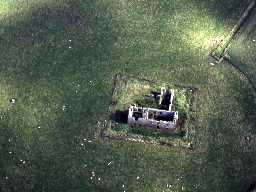Local History
Widdrington Village (Northumberland)

Low Chibburn Preceptory from the air. Photo by Northumberland County Council, 1997.

View across Druridge Bay. Photograph by Harry Rowland, 1980.
Widdrington parish lies in south-east Northumberland, reaching out westwards from the southern half of Druridge Bay. The land generally flat with the exception of the ridge on which Widdrington village sits. This is largely a reflection of widespread opencast coalmining in the area and its subsequent restoration. Along the coastline is a thin strip of sand dunes.
The oldest remains in the parish belong to the Iron Age. Excavations at Widdrington Castle found traces of an Iron Age settlement, sited on a ridge that provides views to the coast and inland.
A possible later settlement lies near Chibburn Farm and shows up as a cropmark on aerial photographs. It probably belongs to the Roman period. Similar sites elsewhere in the county have revealed hut circles inside the enclosure, probably for an extended family, as well as a yard ' possibly for keeping animals.
Much more is known about Widdrington in medieval times when this was the seat of the Widdrington family. A castle survives as an earthwork, although the site was altered in the 18th century to make a Gothick castle. The Church of the Holy Trinity retains many original medieval features. Another medieval building in the parish is Low Chibburn Preceptory which was connected to the Knights Templar. The preceptory was a cross between chapel, accommodation and monastic grange.
The Widdrington family also influenced the post-medieval history of the parish. They took part in the English Civil War and the Jacobite 1715 rebellion, following which Lord William Widdrington's estate was confiscated. The original Widdrington Castle fell out of use and was eventually demolished to be replaced by a Gothick castle with a landscaped park.
The Agricultural Revolution and Industrial Revolution changed the parish physically. New farm buildings were built at Hemscott Hill and coal seams were exploited with a number of collieries at Widdrington. A tileworks was also established here}.
More recently defences were built during World War II (1939-45) with Low Chibburn Preceptory being used to disguise a pillbox and another disguised as a cottage at Hemscott Links, as well as more standard pillbox designs. Concrete blocks were set up along the coastline to stop tanks landing and a bombing decoy was set up east of Widdrington Station.
The oldest remains in the parish belong to the Iron Age. Excavations at Widdrington Castle found traces of an Iron Age settlement, sited on a ridge that provides views to the coast and inland.
A possible later settlement lies near Chibburn Farm and shows up as a cropmark on aerial photographs. It probably belongs to the Roman period. Similar sites elsewhere in the county have revealed hut circles inside the enclosure, probably for an extended family, as well as a yard ' possibly for keeping animals.
Much more is known about Widdrington in medieval times when this was the seat of the Widdrington family. A castle survives as an earthwork, although the site was altered in the 18th century to make a Gothick castle. The Church of the Holy Trinity retains many original medieval features. Another medieval building in the parish is Low Chibburn Preceptory which was connected to the Knights Templar. The preceptory was a cross between chapel, accommodation and monastic grange.
The Widdrington family also influenced the post-medieval history of the parish. They took part in the English Civil War and the Jacobite 1715 rebellion, following which Lord William Widdrington's estate was confiscated. The original Widdrington Castle fell out of use and was eventually demolished to be replaced by a Gothick castle with a landscaped park.
The Agricultural Revolution and Industrial Revolution changed the parish physically. New farm buildings were built at Hemscott Hill and coal seams were exploited with a number of collieries at Widdrington. A tileworks was also established here}.
More recently defences were built during World War II (1939-45) with Low Chibburn Preceptory being used to disguise a pillbox and another disguised as a cottage at Hemscott Links, as well as more standard pillbox designs. Concrete blocks were set up along the coastline to stop tanks landing and a bombing decoy was set up east of Widdrington Station.
N13839
UNCERTAIN
Disclaimer -
Please note that this information has been compiled from a number of different sources. Durham County Council and Northumberland County Council can accept no responsibility for any inaccuracy contained therein. If you wish to use/copy any of the images, please ensure that you read the Copyright information provided.